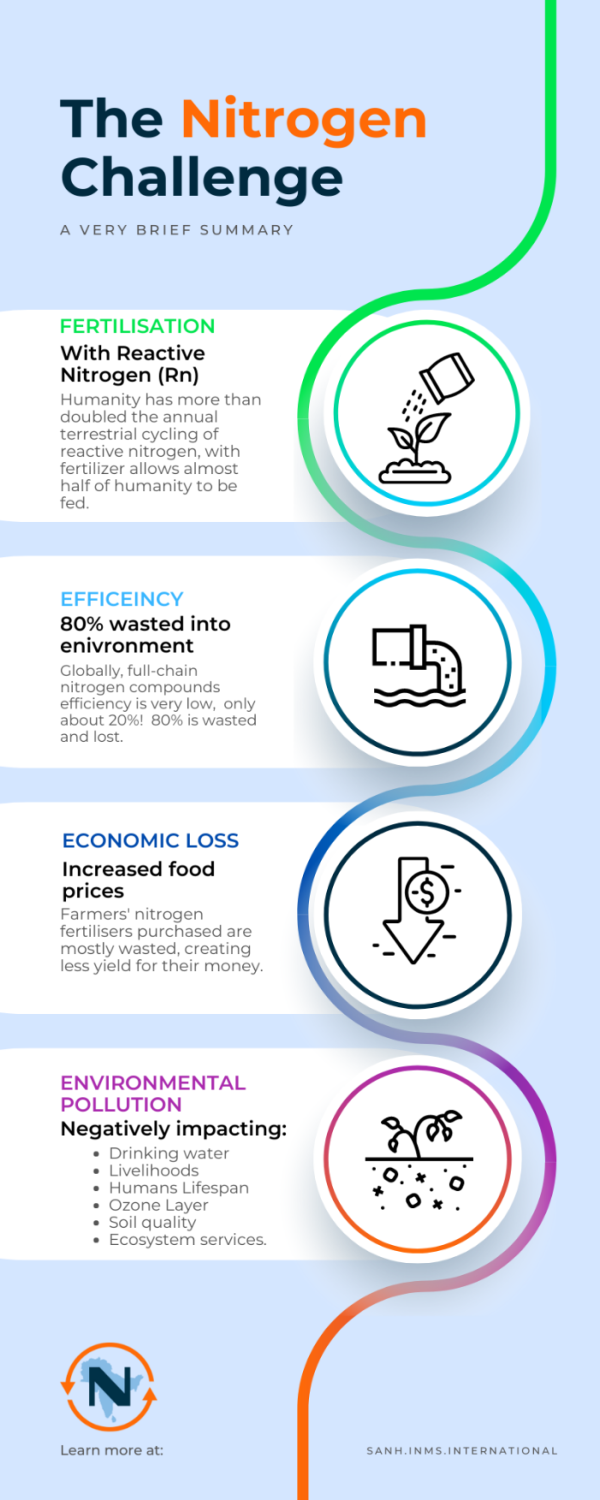Humans have massively altered nitrogen flows on our planet, benefiting food production but creating multiple environmental threats. There are few places on Earth more affected than South Asia, with levels of nitrogen pollution rapidly increasing damaging human health, threatening biodiversity, and contributing to climate change. We are a partnership of 32 leading research organisations and project engagement partners from the UK and South Asia.
Our research includes on how to improve nitrogen management in agriculture, saving money on fertilizers and making better use of manure, urine and natural nitrogen fixation processes. It highlights options for more profitable and cleaner farming for South Asian countries. At the same time, the hub considers how nitrogen pollution could be turned back to fertilizer, for example by capturing nitrogen oxide gas from factories and converting it into nitrate.
Ensuring all SACEP countries are included allows lessons are shared on good experiences as well as on whether there are cultural, economic, and environmental differences that prevent better management practices from being adopted.
It is also important from the perspective of international diplomacy and provides an example to demonstrate how working together on a common problem is in everyone's interest. It puts the focus on future cooperation for a healthier planet, rather than on the past. The South Asian case provides for some exciting scientific, social, cultural and economic research challenges. The first is simply to get all the researchers talking together and understanding each other. There are dozens of languages in South Asia, matching the challenge met when different research disciplines come together. This is where developing a shared language around nitrogen can really help. There are lots of nitrogen forms ranging from unreactive atmospheric nitrogen (N2) to the air pollutants ammonia (NH3) and nitrogen dioxide (NO2), to nitrate (NO3-) which contaminates watercourses, and nitrous oxide (N2O) which is a greenhouse gas. The impacts of each of these are being studied to provide a better understanding of how they all fit together. The result is an approach that aims to give a much more coherent picture of the nitrogen cycle in South Asia: What is stopping us from taking action, and what can be done about it. One of the big expectations is that the economic value of nitrogen will help. India alone spends around £6 billion per year subsidising fertilizer supply. It means that South Asian governments are strongly motivated to use nitrogen better. At which point research from the South Asian hub can provide guidance on where they might start.
Why nitrogen?
Alteration of the global nitrogen cycle is, one of the great intractable development challenges we face today. Humanity has more than doubled the annual terrestrial cycling of reactive nitrogen compounds, with fertilizer permitting almost half of humanity to be fed based on current diets.
If new plant varieties were the engine of the Green Revolution, then reactive nitrogen fertilizers were its fuel.
However, the amount of human produced reactive nitrogen that reaches final products is very low. Globally, full-chain nitrogen use efficiency is only about 20%, with 80% wasted and lost to the environment. This loss is not only economic, but as reactive nitrogen also contributes to numerous problems including:
- Pollution of freshwater and marine systems - drinking water and livelihoods.
- Air pollution - shortening human lives.
- Greenhouse gas emissions - depleting stratospheric ozone.
- Threatening soil quality and ecosystem services.
It makes for an intractable 'wicked problem' that cuts across the Sustainable Development Goals.
Nitrogen is necessary for survival, but our current habits create pollution, which is harming to our health, climate, ecosystems, and livelihoods.
Everywhere and Invisible
There are multiple nitrogen forms, with multiple impacts.
The high-energy state of NH3 and NOx also means that there is a 'nitrogen cascade', through a complex sequence as reactive nitrogen (Nr) compounds gradually revert to low-energy, unreactive N2, whilst on the way multiplying the impacts of newly fixed Nr.
This multiplying of Nr forms and effects also points to the critical problem of fragmentation, across academic disciplines, across traditional policy domains and across the challenges faced by practitioners, be they industrialists, farmers, water companies, vehicle drivers or conservation managers.
It is for this reason that the nitrogen challenge is relevant across almost all 17 sustainable development goals (SDG), and yet unless you look carefully, it is nearly invisible in the SDG indicators. The fragmentation of issues across the nitrogen cycle appears to be one of the key barriers to change, with the result that essential synergies are missed that might otherwise make the difference between action and no action.
These opening comments help point the way towards a future strategy to many of the challenges, we know so well:
"nitrogen is not just another problem rather it is part of the solution"
The nitrogen case shows how integration of linked issues may build the gravity of common cause that helps overcome the barriers to better food security and climate resilience, cleaner air and water, healthier people, seas, and forests.
Why South Asia?
South Asia is critical for the global nitrogen cycle. Its population of ~1.7 billion is increasing at 1.7% annually and is expected to have doubled by around 2050. Fertilizer inputs have similarly been projected to double, to give South Asia the highest nitrogen inputs in the world by 2050.
At the same time nitrogen use efficiency (food produced per nitrogen input) has halved since 1990. Added to this are the increasing intake of livestock products and an alarming annual growth in NOx emissions.
Together these make for an intractable challenge where it will be imperative for South Asia to act and not worsen its already substantial environmental, food and other development concerns.
The partnership between the International Nitrogen Initiative (INI) and the inter - governmental South Asian Cooperative Environment Programme (SACEP) has paved the way for a new perspective. This is built upon the establishment of the International Nitrogen Management System (INMS), in collaboration with INI, UN Environment, the Global Environment Facility (GEF), and SACEP. South Asia is a crucial region for investment to showcase how a comprehensive nitrogen approach can promote sustainable development.

